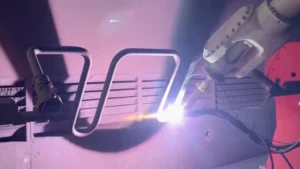table of contents
- Heading 1
- Heading 1
- Heading 1
share this
More companies around the world are adopting robot systems and automating their processes. According to the International Federation of Robotics (IFR), the World Robotics 2020 Industrial Robots report shows a record of 2.7 million industrial robots operating in factories around the world – an increase of 12% from 2019. [1]
However, there are often inevitable challenges that come along with implementing new technologies, such as adopting a robot system, in any organisation. Thus, it is of importance for businesses to be informed of these possible challenges to better prepare for a smoother integration.
1. Cost of Integrating Industrial Robots
Robots are getting cheaper, but it is the integration that makes them expensive. Based on research done by McKinsey back in 2017, although robot prices have generally fallen over the years, implementing a robot system is still a large upfront investment for businesses. [2]

A graph comparing labour costs and robot prices.
Image by: McKinsey&Company
Companies have to consider the cost of automation against the cost of labour before deciding to change: [3]
Costs of Human Labour
- Labour Wages and inflation
- Training
- Worker Insurance
- Safety Equipment
Costs of Automated Processes
- Up-front hardware and software cost plus installation
- Operator training and wages
- Ongoing maintenance
New robots, along with controllers and teach pendants, typically cost around $50,000 to $80,000. A full robot system with complete application components would cost between $100,000 to $150,000. [4]
Despite the hefty costs, robots offer a huge return on investment (ROI) in the long term.
Companies should always calculate their ROI before deciding to integrate robots into their pipeline. Most will use an ROI calculator which, is an effective way of determining if automation is right for you. [5]
2. Workplace Concerns – Keeping up with the pace
The most attractive feature of having a robotics system is the increase in productivity. However, when the adoption rate of automation is too fast, workers may lack behind, thus creating a bottleneck in the production process.

Robot kitchen assistant, Flippy flipping patties in a CaliBurger restaurant
Flippy is the world’s first autonomous robotic kitchen assistant, specialising in flipping burgers. However, after just one day of operation, the $60,000 robot was taken offline. Reason? Its human co-workers were unable to prepare patties for the grill at the same speed as Flippy. Hence, the restaurant decided to train the human workers first to keep up with Flippy’s pace. [6]
This example emphasises the importance of training and upskilling workers. Thorough training is needed to ensure that workers are familiar with the pace of automation. Productivity can only be achieved when humans and robots can work together in sync.
Workplace Safety when handling Industrial Robots
According to the Occupational Safety and Health Administration (OSHA), there are seven potential robotic hazards and four categories of industrial robotics-related accidents: [7]
Robotic Hazards
- Unauthorized Access
- Mechanical Failures
- Improper Installation
- Human Errors
- Control Errors
- Environmental Sources
- Power Systems
Industrial Robots Related Incidents
- Impact or collision accidents
- resulting from unpredicted movements, component malfunctions of the robot.
- Crushing and trapping accidents
- of workers limbs or body parts caught between a robots arm or equipment.
- Mechanical part accidents
- resulting from breakdown of robots’ drive component, tooling or end-effector
- Accidents from leaking high-pressure lines, arc flash, metal spatter, dust, electromagnetic, or radio-frequency interference
Though these hazards and accidents are dangerous, they can be prevented by providing a constant examination of mechanical parts for wear and tear. Workers should also be well trained on the robotic system and robotic integrators should ensure proper installation and programming. [8]
Businesses should also have a safety assessment in place. Risk assessments at every stage of a robot’s development are also important to reduce risks.
Here’s an example of a safety assessment checklist
- Safety training for workers dealing with machinery
- Personal Protective Equipment (PPE): respirators, gloves, face shields, hearing protection, hard hats, and safety glasses
- Engineering controls such as physical barriers, guard rails, presence-sensing safeguarding devices to restrict access to hazard zones
- Operator safeguards to protect the operator and reduce injury risk
- Examine mechanical parts for wear and tear
- No one is allowed to enter the operational area of a robot without first putting the robot on “hold,” in a “power down” condition, or at a reduced operating speed mode
3. Cybersecurity within Industrial Robots
According to a research report by cybersecurity firm Trend Micro and Italian university Politecnico di Milano, tens of thousands of industrial robots are vulnerable to cyber attacks due to inadequate protections in place. [9]

A gif showing a hacker altering’s the controller’s parameters. Image by Trend Micro
Since most robot systems are on the cloud today, there is a real possibility that hacking may occur. If a hacker changed a controller’s parameters or tampered with the robot’s production logic, it could potentially cause manufacturing disruptions.
“Cybercrime is the greatest threat to every company in the world.” Ginni Rometty, former CEO of IBM
Companies should ensure that their employees are educated in cybersecurity, especially since humans are the weakest link in cybersecurity. To protect the robots from cyber attacks, suggested cybersecurity strategies should be fully implemented in the industrial robot ecosystem. [10]
Final Thoughts
There will always be challenges to implementing changes within any system. It is good to always plan and take measures to prevent or minimise possible risks in adopting a robot system. After all, robots are far from perfect and are prone to mistakes. Perhaps in the future, they will be intelligent enough to identify errors.
Regardless, the benefits of implementing a robot system, such as the increase in productivity and huge cost savings will certainly outweigh the possible drawbacks listed in the long run.
About Augmentus
Augmentus offers a no-code and fully-integrated robotic programming software that enables anyone, even those with no robotic experience, to program dynamic industrial robots in minutes. Our proprietary technology incorporates an intuitive graphical interface on an iPad that eliminates the need for coding and CAD files in robot teaching. Companies using Augmentus have experienced up to 70% cost reduction and 17 times faster deployments across a wide variety of applications, such as spraying, palletizing, welding, and inspections. Augmentus ushers in a new era of human-machine interface, democratizing robotic automation.
Book a demo now to experience it.
References
- [1] IFR presents World Robotics Report 2020
https://ifr.org/ifr-press-releases/news/record-2.7-million-robots-work-in-factories-around-the-globe - [2] Automation, robotics, and the factory of the future
https://www.mckinsey.com/business-functions/operations/our-insights/automation-robotics-and-the-factory-of-the-future - [3] AUTOMATION OR HUMAN LABOR? HERE’S WHAT TO CONSIDER
https://www.arnoldmachine.com/automation-or-human-labor-heres-what-to-consider/ - [4] How Much Do Industrial Robots Cost?
https://www.robots.com/faq/how-much-do-industrial-robots-cost#:~:text=How%20Much%20Do%20New%20Robots,anywhere%20from%20%24100%2C000%20to%20%24150%2C000. - [5] ROI Robot System Value Calculator
https://www.automate.org/robotics-roi-calculator - [6] Flippy gets fired: Burger bot shut down after one day on the job
https://www.digitaltrends.com/cool-tech/flippy-burger-flipping-robot-shut-down/ - [7] 7 Industrial Robotics Hazards and How to Avoid Them
https://www.bastiansolutions.com/blog/7-industrial-robotics-hazards-and-how-to-avoid-them/ - [8] The Robots are Here. How Do We Work Safely with Them?
https://ohsonline.com/articles/2019/11/19/the-robots-are-here-how-do-we-work-safely-with-them.aspx?m=1 - [9] Rogue Robots: Testing the Limits of an Industrial Robot’s Security
https://www.trendmicro.com/vinfo/us/security/news/internet-of-things/rogue-robots-testing-industrial-robot-security?ClickID=db2nhmt0rbocrx2bz0hwbn0yscyc0s0mshsm - [10] Rogue Robots: Testing the Limits of an Industrial Robot’s Security PDF
https://documents.trendmicro.com/assets/wp/wp-industrial-robot-security.pdf




